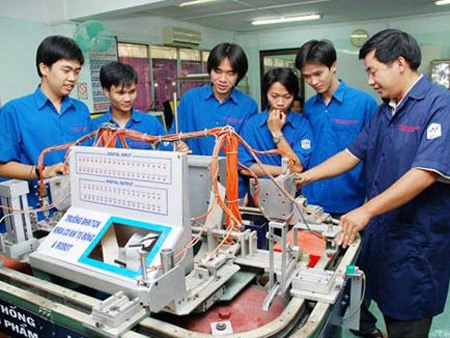Vocational training revamp needed
 |
| The private sector is crucial to building a standardised vocational training system by 2020, thus improving the quality of human resources to regional and world standards. – Photo hanoimoi.com.vn |
The event, held by the Ministry of Labour, Invalids and Social Affairs (MOLISA), the French Development Agency (AFC) and UNESCO in Việt Nam, aims to call for stronger involvement of the private sector in the efforts.
According to the MOLISA, there are about 2,000 vocational training facilities nationwide, half of which are owned privately.
In past years, the Party and State have allocated considerable resources for vocational training, while issuing various policies to support the work, including the Law on Vocational Training in July 2015 and the Strategy for Vocational Training Development from 2011-20.
Major objectives of the strategy include planning vocational training facilities based on sector, region and locality, with priority given to non-State newly-established facilities.
The strategy also encourages foreign-funded facilities, while calling for the engagement of the private sector in the field and diversifying resources for the expansion of vocational training.
Participants pointed to a number of shortcomings in Việt Nam’s vocational training, including poor capacity of training facilities, especially in management, as well as loose co-ordination between training facilities and businesses.
They stressed the need for stronger engagement of private firms to increase the competitiveness of vocational training facilities.
They suggested the Party and State hold public-private dialogues to strengthen the role of trade associations and the business community in vocational training.
It is necessary to build training programmes towards renovation and modernisation to suit market requirements, while designing support policies for non-State facilities, according to participants.
What the stars mean:
★ Poor ★ ★ Promising ★★★ Good ★★★★ Very good ★★★★★ Exceptional
Latest News
More News
- Protect what’s next: towards a future free from meningococcal group B disease (December 05, 2025 | 18:00)
- New ILO report offers policy recommendations for disability inclusion (December 04, 2025 | 15:18)
- Maternal job loss may affect children’s mental health, research shows (December 03, 2025 | 19:11)
- Women lead Vietnam’s shift to climate-resilient agriculture (December 03, 2025 | 19:10)
- Experts highlight unpaid care work as key barrier to gender equality (December 03, 2025 | 15:15)
- Opportunities and inequalities for women workers in Vietnam's garment industry (December 03, 2025 | 09:00)
- Vietjet flights carry love to devastated central region (November 28, 2025 | 11:35)
- New initiative to boost the fight against domestic violence (November 26, 2025 | 10:00)
- South Korea funds IOM relief for Vietnam’s typhoon-affected communities (November 24, 2025 | 15:33)
- AI and human-centred values set to shape the future of HR in Vietnam (November 21, 2025 | 18:04)

















 Mobile Version
Mobile Version